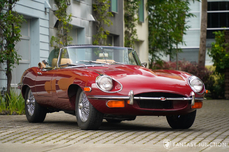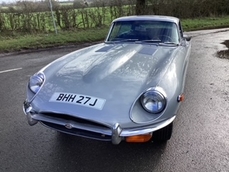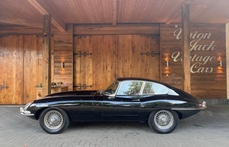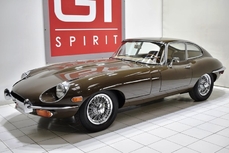Jaguar E-type Roadster 1968
General description :
Throughout the iconic E-Type’s long production run, Jaguar made a host of running changes to improve the car’s performance and reliability, all while trying to keep pace with a rapidly changing automobile market. Ever-evolving safety and emissions regulations, particularly in the critical American market, were like a moving target. For a small company like Jaguar, keeping up was a constant battle. Without the resources of a major automaker, many of the necessary evolutions of the E-Type took place gradually as parts were used up and new items introduced to the assembly line. As a result, E-Types come in a variety of specifications, some with more drastic changes than others, and each with a unique character and loyal enthusiast following.
After the original 3.8-liter model set the stage for the E-Type’s success in 1961, an improved 4.2-liter version of the E-Type superseded it for the 1965 model year. Torque and flexibility improved, and a revised interior offered superior comfort. New regulations from the USA forced Jaguar’s hand to change the E-Type again in late 1967. Halfway through the model year, the covered headlamps of the original design gave way to a new, safety-mandated open headlamp layout that carried over to the Series II, while the rear of the car remained unchanged. Other differences included the use of rocker switches in place of toggles and the fitment of twin Stromberg carburetors in place of the triple S.U. carbs in a bid to improve emissions. These interim cars are colloquially known as “Series 1.5” (officially, they are still within the Series 1 4.2-liter series). Series 1.5’s differ from car to car as Jaguar used up stocks of old parts. By late in 1968, the fully developed Series II arrived, marking the end of the very short-lived, interim Series 1.5.
This 1968 E-Type OTS roadster is one of a handful of original Series 1.5 models produced. This example features select improvements to “backdate” the car closer to desirable Series 1 specification and is the subject of a good-looking amateur-level cosmetic restoration. Finished in Carmen Red over a black interior, the car is crisp and attractive with good detailing all around. The most obvious alteration is the fitment of an earlier, covered-headlamp Series 1 bonnet which brings the E-Type back to its classic, original styling. The Carmen Red paintwork is consistently glossy and appealing, with a few minor imperfections and evidence of filler found on closer inspection. Overall, however, the bodywork appears to be very good, with straight reflections and satisfactory panel fit. The brightwork is similarly attractive, with restored bumpers and wheels mixed with good original minor trim pieces. The chrome wire wheels are in excellent condition, wearing correct non-eared knockoffs and recently-fitted black wall Vredestein Sprint Classic radials.
The black upholstery presents in excellent order for an enjoyable driver’s car such as this. This car saw regular enjoyment in the hands of the most recent owner, and the interior shows some signs of use while remaining clean, tidy, and in fine overall condition. Rocker switches give this away as a Series 1.5, and the remainder of the switchgear and instrumentation consists of good original items. The interior is mostly standard save for a modern stereo and speakers in the original location in the center console. Door panels and sills are covered with correct vinyl material, and the black carpets are clean and tidy. Tan Stayfast canvas topping is in good condition, save for a couple of minor cosmetic blemishes that do little to detract from its function or overall presentation.
Beneath the clamshell bonnet sits the legendary 4.2-liter, twin-overhead camshaft XK inline-six. A trio of S.U. carburetors sit in place of the troublesome, emissions-choked twin Stromberg setup. This proven arrangement not only frees up a few ponies, but it is also simpler to maintain and far more tractable on the road. The engine number matches that on the chassis tag, and the cylinder head retains the original late-style fluted cam covers. Wisely, the improved braking and twin-fan cooling systems of the S1.5 are in place. Coming from a period of storage, some minor additional sorting may be necessary to return the car to full health. Chassis upgrades include a full set of Spax adjustable dampers front and rear, and the undercarriage presentation is honest and appropriate for an enjoyable driver’s car.
With its attractive presentation and subtle upgrades, this E-Type OTS represents excellent value for the enthusiast; delivering the looks and performance of the iconic early E-Type combined with the improved road manners of the later models. This sharp example is well-suited for club events and regular on-road enjoyment.
Offers welcome and trades considered
https://hymanltd.com/vehicles/6493
1968 Jaguar E-type Roadster is listed sold on ClassicDigest in St. Louis by Mark Hyman for $72500.
Car Facts
Car type : Car Make : Jaguar Model : E-type Model Version : Roadster Engine size : 0.0 Model Year : 1968 Sub type : Convertible Location : Missouri
Sold
Seller Information
Sold
People who viewed this Jaguar E-type also viewed similar Jaguar listed at ClassicDigest
Other cars listed for sale by this dealer
About Jaguar E-type
The Jaguar E-Type FHC (Fixed Head Coupe) is a classic sports car that was produced by the British automaker Jaguar Cars from 1961 to 1974. It is often regarded as one of the most beautiful cars ever produced, with its long, sleek hood, flowing curves, and aggressive stance.The E-Type FHC was derived from the D-Type race car that won the 24 Hours of Le Mans in 1955, 1956, and 1957. It was powered by a 3.8-liter inline-six engine that produced up to 265 horsepower and featured advanced suspension and braking systems, with independent suspension and disc brakes on all four wheels.
The E-Type FHC was known for its exceptional handling and performance, with a top speed of up to 150 mph and acceleration from 0 to 60 mph in as little as 6.7 seconds. Its design was also innovative for its time, featuring an independent rear suspension and a monocoque construction.
The Jaguar E-Type FHC became an iconic car of the 1960s and was favored by celebrities and enthusiasts alike. OTS i.e The Jaguar E-Type Roadster became an iconic car of the 1960s and was favored by celebrities wanting to be seen in their car.











